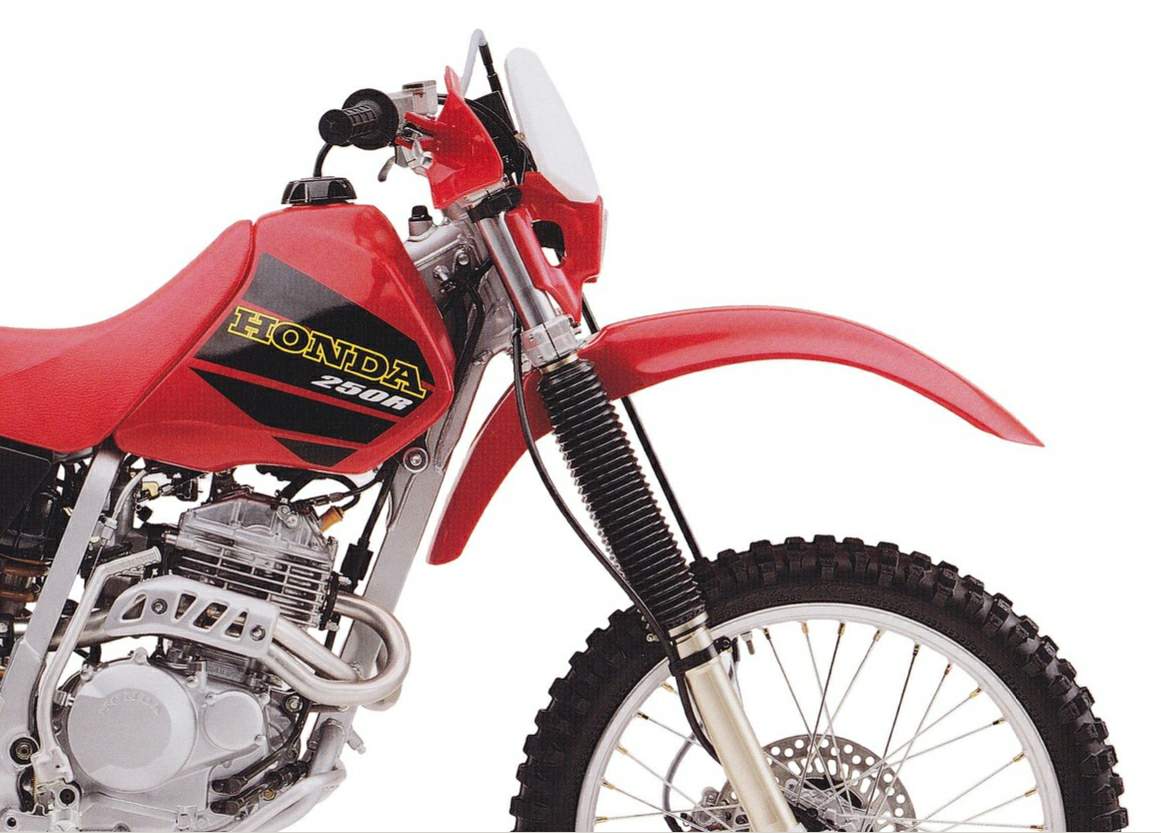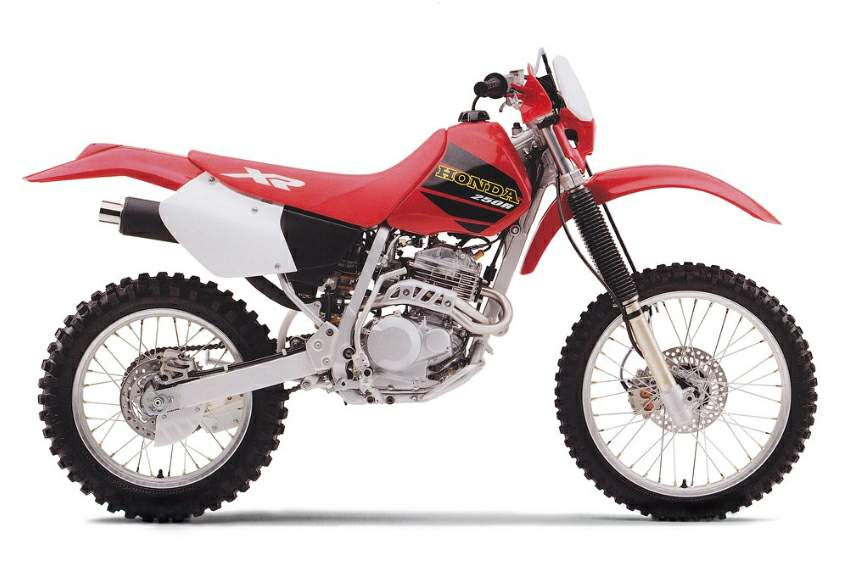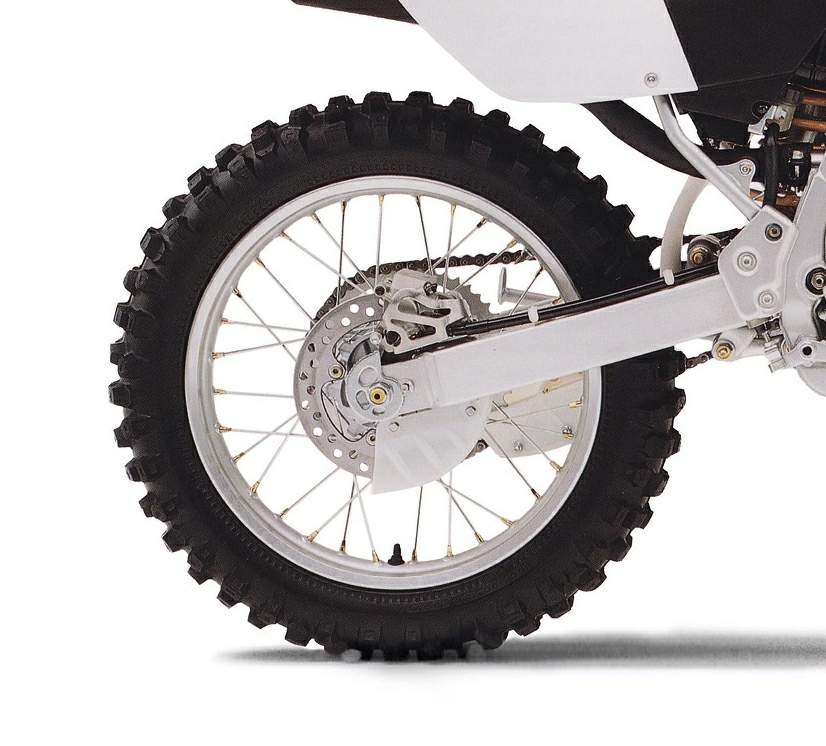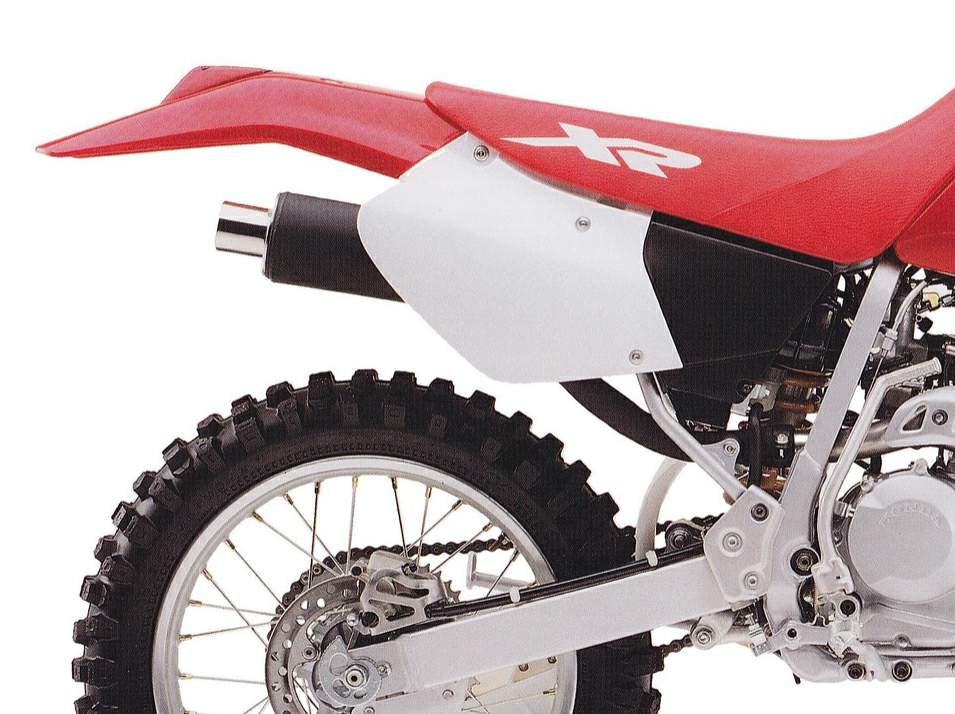
|
|
|
|
|
|
Classic Bikes
Custom Bikes
Individual
Racing Bikes AJP
AJS
Aprilia
Ariel
Avinton / Wakan
Bajaj
Benelli
Beta
Bimota
BMW
Brough Superior
BRP Cam-Am
BSA
Buell / EBR
Bultaco
Cagiva
Campagna
CCM
CF Moto
Combat Motors
Derbi
Deus
Ducati
Excelsior
GASGAS
Ghezzi Brian
Gilera
GIMA
Harley Davidson
Hero
Highland
Honda
Horex
Husaberg
Husqvarna
Hyosung
Indian
Jawa
Kawasaki
KTM
KYMCO
Laverda
Lazareth
Magni
Maico
Mash
Matchless
Mondial
Moto Guzzi
Moto Morini
MV Agusta
MZ / MuZ
NCR
Norton
NSU
Paton
Peugeot
Piaggio
Revival Cycles
Roland Sands
Royal Enfield
Sachs
Sherco
Sunbeam
Suzuki
SWM
SYM
Triumph
TVS
Ural
Velocette
Vespa
Victory
Vincent
VOR
Voxan
Vyrus
Walt Siegl
Walz
Wrenchmonkees
Wunderlich
XTR / Radical
Yamaha
Zero
Video
Technical
Complete Manufacturer List
|
Honda XR 250R |
| . |
|
Make Model |
Honda XR 250R |
|
Year |
2002 - 03 |
|
Engine |
Four stroke, single cylinder SOHC, 4 valve |
|
Capacity |
249 cc / 15.1 cu-in |
| Bore x Stroke | 73 x 59.5 mm |
| Cooling System | Air cooled |
| Compression Ratio | 10.2:1 |
| Lubrication | Dry sump |
|
Induction |
PD30 Carburetion |
|
Ignition |
CDI type magnetic Ignition System |
| Starting | Kick |
|
Max Power |
30 hp / 21.9 kW @ 9000 rpm |
|
Max Torque |
24.5 Nm / 18 ft. lbs @ 7500 rpm |
|
Transmission |
6 Speed |
| Final Drive | Chain |
|
Front Suspension |
41 mm Air assisted telescopic forks |
| Front Wheel Travel | 280 mm / 11.0 in |
|
Rear Suspension |
Pro-Link, adjustable compression and rebound |
| Rear Wheel Travel | 280 mm / 11.0 in |
|
Front Brakes |
Single 240 mm disc 2 piston caliper |
|
Rear Brakes |
Single 220 mm disc 1 piston caliper |
|
Front Tyre |
80/100-21 |
|
Rear Tyre |
100/100-18 |
| Rake | 26.5° |
| Trail | 105 mm / 4.1 in |
| Dimensions |
Length: 2110 mm / 83.1 in Width: 830 mm / 32.7 in Height: 1215 mm / 47.8 in |
| Wheelbase | 1400 mm / 55.1 in |
| Seat Height | 920 mm / 36.2 in |
| Ground Clearance | 315 mm / 12.5 in |
|
Dry Weight |
104 kg / 229.3 lbs |
|
Fuel Capacity |
9 Litres / 2.4 gal |
| . |
Meet the Jan Brady of Honda's off-road lineup. Despite several major changes for 1996, the new XR250R remains somewhat overshadowed by all the press attention given to it's bigger sibling, the XR400R. Here to rectify the quandary we've contributed to is a detailed report of our experience with Honda's quarter liter XR one year later.
For the past nine years Honda's mid-sized four-stroke dirt bike has remained essentially unchanged. Introduced in 1979, this aggressive play-bike has been inducing smiles from owners the world over. Interestingly, it had the same effect on us. If you're looking for a first trail bike, crave a mid-sized woods machine, or perhaps you'd just like to get back into the sport on a casual basis, the XR is a viable candidate for that empty spot in your garage.

This bike is all it's cracked up to be. What's New? We were truly impressed by the performance of the new XR. No shortcuts here. Honda's engineers have breathed new life into the powerplant, claiming higher torque and improved responsiveness. A new carburetor, lightweight dual exhaust and a freer-breathing muffler are now par for the course. A dry sump lubrication system, aluminum clutch center, trimmed-down balancer and kickstarter idle gears, as well as a hollow-section shifter shaft all help to reduce engine weight and size. A lighter, smaller frame is alleged to have increased rigidity and enhanced turning responsiveness over previous models.
Suspension and brakes, both front and rear, are entirely new. The transmission has been updated with a new involute spline countershaft that improves cog movement, a polished shift fork guide, and all-new gearshift cam design. For those of us with little idea of what an involute spline countershaft is, the changes translate into more precise shifting and less work than before.
The 250's new kickstart mechanism is similar in design to that of the XR600R's. Indeed, very little effort is required to crank the eager engine over. There are no systematic starting drills to adhere to either. In the event that it's needed, the XR is equipped with a manual decompression lever.

It seems whenever we get a new dirt bike, our staff street-weenies bicker over who gets to climb aboard first. More accurately this begins the contest of who can fall off first. Well, our test of the XR was no exception and in no time the XR became the designated machine on which off-road neophytes would be schooled on how to do it in the dirt. Needless to say the XR soon was spending more time sliding on its side than rolling down the trail.
Even after a high speed high-side by one of our "evaluators" the bike suffered little more than scratches and a minimally tweaked front end. The forks twisted in their clamps but were quickly returned to their original position without any permanent damage. Suffice it to say the XR is extremely tough and great to learn on. Experienced riders will find they can travel at a brisk pace thanks to the XR's sophisticated suspension, while our less-experienced friends will extol over the Honda's user-friendliness.
Honda has scrapped the XR's conventional lubricating system in place of an all-new dry sump design. The concept, claimed to markedly improve cooling, uses the front section of the frame as an oil reservoir . Oil is forced through the frame, while large cooling fins on the motor provide a departure point for heat. No complaints here. On several hot summer days we rode the machine all afternoon and never once experienced any noticeable decrease in horsepower or symptoms of engine overheating. In fact the lack of water cooling combined with a dry sump lubrication system keeps engine weight down to a mere 74.3 pounds.
In stock form the motor produces torque and horsepower at low to mid-range rpm ranges. Honda credits the XR's grunt to a design concept they've utilized for over ten years. The Radial Four Valve Combustion chamber (RFVC) allows for the use of large valves, better flow and a unique valve actuating method. Due to the positioning of the sub-rocker arm, the rocker arm and valve operate on different planes, theoretically enabling the entire valve train to last longer. Power delivery is brisk by four-stroke quarter-liter standards. While considerable shifting is required to keep the fun happening in tight or sandy terrain, you can tool around all day on trails without necessitating a full Shim Sham tap dance routine on the shifter.

However, aggressive riders will be asking Santa for a few extra ponies come Christmas. Fortunately there are a plethora of aftermarket goods readily available, including kits to boost displacement to a full 300cc.
Clutch action is surprisingly light and smooth. Our clutch held up well despite a day of heavy flogging out at the MO sand track. In fact all of the controls, borrowed directly from the CR motocrossers, worked well and proved easily adjustable.
Stopping the thumper are the same high quality Nissan units found on Honda's MX machines. There is no shortage of braking power here. As with our XR400, action is extremely light and resistant to fade at both ends. Suspending the XR up front is a pair of fat 41mm cartridge forks with 10.6 inches of front wheel travel and 20-position compression damping adjustments. The new configuration reduces underhang significantly over the old design. Construction is similar to that used on the CBR900RR street rocket. In the rear a Showa single shock features 20-position compression and rebound damping adjustability.
Flimsy plastic brush guards, an Enduro style headlight, resettable odometer, folding footpegs, O-ring chain, snail-cam adjusters, and a quick detach rear wheel make for a complete offering. While we did manage to bend the folding shift lever, it withstood some serious rock abuse and bent back without showing signs of weakness.
The combination headlight/numberplate design is first rate; the multi-piece assembly quickly detaches when you don't need it. And since it's two separate components, the likelihood of having to replace both in a crash is reduced. In the event it is needed, Honda offers an optional 55W bulb over the stock 35W. A short 55.1 inch wheelbase combined with a 24 degree rake make for a fast-handling unit. However, straight line stability is slightly compromised as a result. Despite tinkering with the suspension we were unable to eliminate some minor headshake experienced primarily under deceleration. The condition sometimes occurred while gassing it up at speed, but under these circumstances it was more manageable.

Details
Bodywork is sleek, and quick to remove. The low seat height and overall ergonomics make for a comfortable fit for most riders. The seat is comfy and slim, as is the tank, allowing the rider to move around without restriction. The engine's gear driven counterbalancing system does a great job of reducing vibration to the handlebars, and the all-new exhaust system features a spark arrestor and removable baffle. A hinged-cover airbox makes for one of the best designs we've seen in terms of air filter serviceability.
The 1997 model is identical to last year's with the exception of a new white, red and black color scheme, like that used by Honda's off-road racing team. The suggested retail price for the '97 model is $4599. Combine that with a transferable six-month warranty and you've got the ingredients for one of the best beginner off-road recreational packages available.
Source Motorcycle.com
|
Any corrections or more information on these motorcycles will be kindly appreciated. |